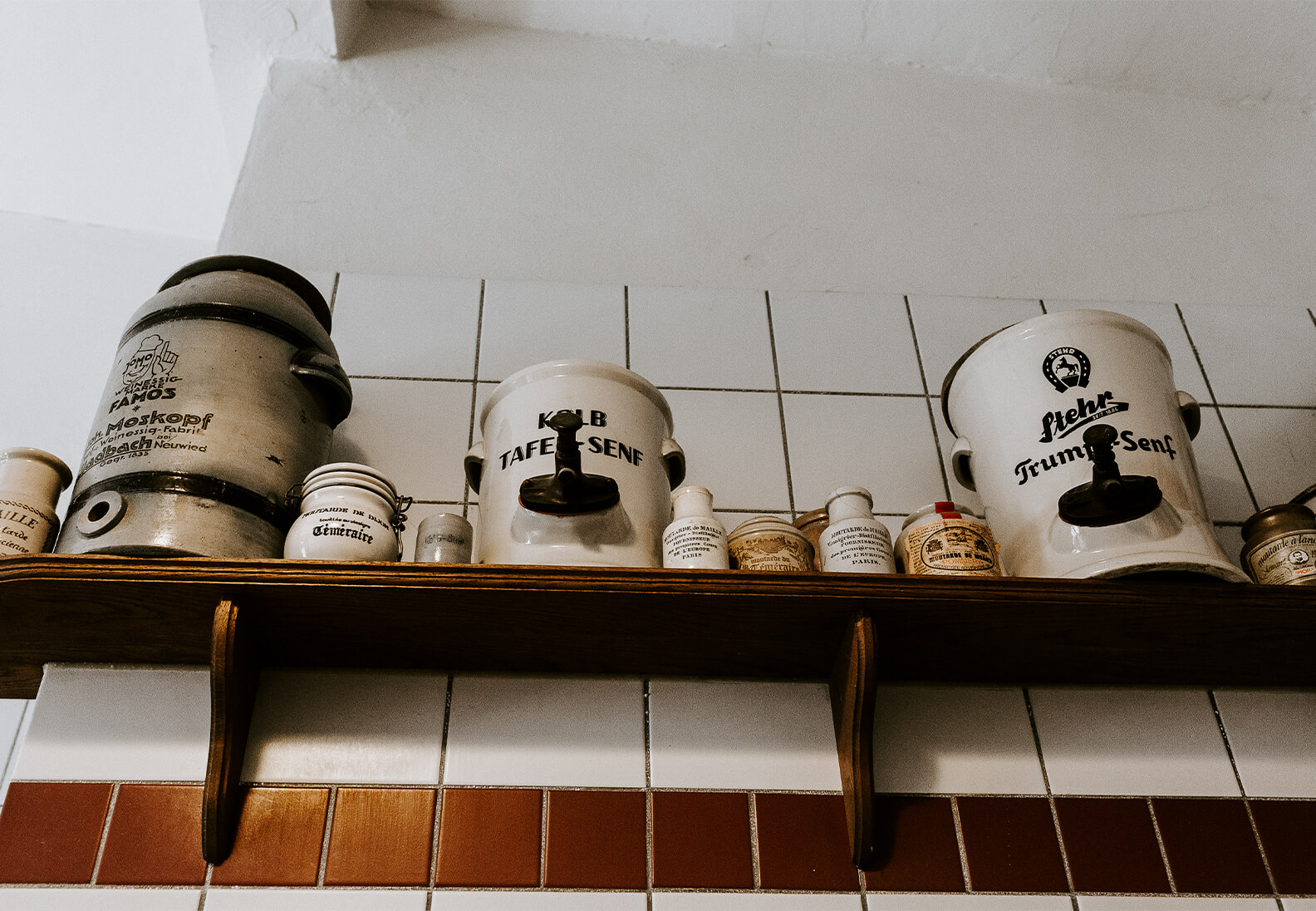
»The historic Monschau mustard mill«
Author Sophia Schillik visited the historic mustard mill in Monschau and reportes in a big sisterMAG feature about the spice, its production and the mill in Monschau. Learn also more about how practical and helpful mustard can be.
- Text & Photos: Sophia Schillik
Mustard Feature:
»The historic Monschau mustard mill«
What is mustard anyway?
Mustard is a hot spice which is usually processed into a ready-to-use paste made from the seeds of the mustard plant. The yellow-flowering, robust weed finds relatives in radish, cress and rapeseed. The mustard seeds ripen in the pods of the plant, which can measure up to a metre in height. Similar to wheat, mustard is harvested, dried and threshed. The extracted seeds are dried again and usually ground to flour on-site. Mustard is a product rich in tradition, beginning as a healing and luxury food in ancient Egypt and antiquity, then a fine ingredient for emperors, kings and popes, and later the »spice of the everyman«.
The 5th generation of mustard production
In Germany, the cultivation of the mustard plant has practically fallen into oblivion. Today, mustard is almost exclusively produced industrially by high-performance machines in large factories. But there are exceptions. Among them is the historic Monschau mustard mill in the Eifel region. In its fifth generation, an almost extinct craft is practiced here. Ruth Breuer, who studied German and sociology, took over the mustard mill from her father, Guido. She still produces mustard in the same way as her great-great-grandfather did 130 years ago: with love, patience and deliberation. Heavy millstones made of Eifel basalt (a type of volcanic rock) grind the mash of mustard flour, water and vinegar in two stages. Such a traditional method is practiced by very few mustard millers today. In particular, cold grinding is decisive for quality and taste. By not heating the mash, the mustard retains its natural sharpness. Its ingredients form an intimate bond. This step of the production makes the mustard creamy and ensures depth and fullness of flavour. Breuer gets most of the ground grain from Eastern Europe. For a long time she was looking for someone to grow mustard in Germany. »In the past,« says the mustard expert, »the same was true of coal. But the profession eventually died out.« Her grandfather bought his mustard flour from Canada in the 1950s.
The cradle of mustard
Mustard is one of the oldest and most recognized spices in the world. Already mentioned in the Bible, its roots go back even further, probably to ancient Egypt. From there, the Romans brought the mustard plant to Central Europe. They were drawn to its seasoning power and later adapted the knowledge of its healing effect from the Greeks. The Greek doctor Pedanius Dioscorides described the health-promoting properties of mustard in the first century A.D. It was recommended for snake bites, the bubonic plague and hysteria, and was considered to promote blood circulation and digestion as well as boost anti-inflammatory properties.
The Romans also used it to conserve food and used the grains to season a then very popular drink: unfermented grape juice, called must. »Mustum« (Latin) was also used to mix with the paste from ground mustard flour. A Latin loan word for »mustard« remains to this day: sināpi, a term for »Mostrich«, or »Mostert«. In German, »Senf«, and in French, »Moutarde«.
Through the Romans, mustard found its way across the Alps to Central Europe and onto the menus of clergy and nobility. Charlemagne made mustard socially acceptable in Germany and officially endorsed its cultivation. Pope John XXII, who resided in Avignon, appointed his nephew »Grand moutardier du Pape«, the »Pope’s Great Mustard-Maker«. Mustard became a fine-tuned staple, that certain something in many a courtly dish. After all, it was not until the 13th century that spicy seasonings such as pepper were available; the chili pepper found traction in the 15th century.
The French, in particular, were crazy about the wonderfully hot yellow paste. In the 13th century, Dijon became the epicentre of French mustard production. In the 14th century, strict quality guidelines turned the city into a mustard metropolis. The Dijon secret was not to produce with vinegar, but with verjus, the juice of unripe grapes. To this day, Dijon mustard is regarded as the epitome of the art of mustard. Meanwhile, it is mostly mass produced in China.
A recipe from great-great-grandfather’s kitchen
The Germans also contributed to the global mustard map. The first German mustard factory was founded in Düsseldorf in 1726. ABB mustard became the benchmark. Ruth Breuer’s great-great-grandfather, Clemens August, an enterprising Jack of all trades, had his wife, Mathilde, prepare mustard in her home kitchen and brought it to market in 1882 as »Kaisersenf«. Made from light Dutch mustard seed, aromatic herbs, and piquant spices, it was crafted especially for the emperor’s birthday.
Since then the Breuer family’s mustard mill has been rumbling in Monschau. The exact recipe is still a family secret. The small Monschau company has persistently stood up to competition from big producers. It is both conscious of its tradition and modern. The old water wheel that used to drive the mill still exists in town, opposite the red house where it all began. The transmission belts have long been moved by electricity. Nevertheless, the old mill is still running just as it did at the end of the 19th century. Now at home on the outskirts of Monschau, the historic mustard mill still manages to produce the same quantity as the original recipe every day, about eight kilograms. The rest is replicated at a 1:1 scale: »We produce about 400 kilograms of mustard here every day,« says Ruth Breuer. If that sounds like a lot, consider that the industry produces 10,000 kilograms per hour. Mass instead of class. And no comparison in taste.
Mustard as a remedy:
The healing power of mustard was already harnessed by the ancient Egyptians and Greeks. It is also mentioned in medical writings by the Arabs and later in medieval medicine. It promotes blood circulation and is an herbal antibiotic. For acute infections, coughs, colds and bronchitis, a compression wrap with mustard paste can help to loosen mucus and relieve inflammation.
Ingredients for a mustard wrap:
- 1 – 2 tablespoons mustard flour
- Linen cloth, wool cloth or terrycloth
- Vaseline, cotton wool pads, St John’s wort oil
Application
- Cover or lubricate nipples to avoid irritation
- Spread the mustard flour evenly in the middle of the cloth. Wrap the cloth from above and below and wind up. Dip into warm water and wring out. Carefully roll up again and place on breast. Fasten with the wool cloth, cover. Leave to absorb for 5 – 10 minutes, then remove the wrap.
- Carefully rub the skin with a natural skin oil (St John’s wort oil, lavender oil or thyme oil) in order to relieve any burning sensation.
Mustard as a delicacy:
We owe the first traditional mustard recipe to Palladius from the 4th century A.D. He mixed crushed mustard seeds with honey, olive oil and vinegar – still the basis of mustard today. Some countries, such as India, also use mustard oil pressed from the seeds as a pickling brine. Pickled mustard grains, as an addition to sour cucumbers or as mustard caviar, are special delicacies.
Hot stuff:
The darker the seeds, the spicier. Usually light mustard seeds (Sinapis alba) are mixed for seasoning and brown mustard seeds (Brassica juncea) for a spicy kick. Black mustard (Brassica nigra) is rarely used. Interestingly, only water is capable of releasing the spicy mustard oil. The characteristic pungency only develops when the flour is mashed or the small seeds are chewed.
As a craft:
At the beginning of the 20th century, mustard was in high demand. More than 300 mustard factories, many of them vinegar factories with secondary production units, existed in the German Reich in the 1930s. One can count on one hand the few functional mills that remain.
It is a major challenge to maintain them or replace certain parts as the trade association of mill builders is hardly represented in Germany these days. A millstone today is sawed while the groove system through which the mash is driven to the outside is copied from the original stone and integrated into the new millstone. At the beginning of the 20th century, millstones were still sharpened by hand.
Five generations of love for mustard:
»Moutarde de Montjoie«, the Monschau mustard, has been produced locally for more than 130 years, partly still at the old mustard mill of Ruth Breuer’s great-great-grandfather, with whom it all began.
Mustard production today as it was then:
Production is divided into separate processes: mashing and double grinding. Even after 130 years, the ingredients for the original recipe remain the same. The mustard flour, water and vinegar mash is still mixed exactly as it was then and pumped into the mill. Then it is driven outwards over the circular grooves in the stone, pumped again and ground again. The grinding process loosens the mustard oils and combines them with the remaining ingredients. In the traditional mustard mill this is achieved between heavy sand or granite stones. This avoids excessive heat from developing. Heat would destroy the essential oils, which provide mustard’s distinct spice. In industrial operations it is therefore necessary to add horseradish to the recipe.






